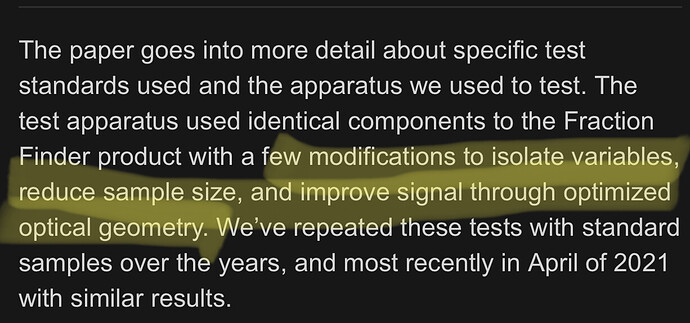We think this dialogue is productive, and asking to see our initial data makes sense. A quick bit on context:
The Arometrix technology is an in situ process monitoring tool, not an analytical benchtop tool. The purpose of this technology is to make process decisions that help improve the manufacturing process. It’s optimal implementation involves putting the unit in line, and empirically observing what is “a good run” versus a “bad run”. Comparing the technology to an HPLC result is interesting, but not entirely proper, as HPLC is an analytical tool, while the Arometrix device is used to give operators information during processing to improve outcomes, i.e. to be able to make more “good runs”. . This is achieved by the operator by adjusting the process parameters in order to see in real time the same patterns and signatures that characterize the “good run”. One of the reasons we chose to use the term “arbitrary units” on our y axis is to highlight the fact that what we are detecting and showing are really trends and patterns rather than giving quantitative cannabinoid measurement of concentrations.
Extraction and distillation process involve a complex mixture of organic compounds. While our research suggests that some cannabinoids fluoresce, so do many other compounds in the distillate and extract. Some are there all the time, but some of them may appear depending on the raw material or other previous processing operations. There are byproducts, fats/lipids, oils, and pigment molecules unrelated to cannabinoids that may fluoresce. Chlorophyll is an example of one of these. Further, fluid clarity and turbidity of the mixture matter… how much signal can actually get through, how much scattering there is and general “cleanliness” of the optical path. Marmoris described this well in his post. Another interesting characteristic we see is that chlorophyll gives a stronger response than other molecules that we typically see in distillation and extraction mixtures.
From our paper, below is the summary of what we tested:
https://arometrix.com/wp-content/uploads/2020/03/In-Situ-Fluorescence-Spectroscopy.pdf
|
Chemical |
Concentration |
Excitation |
| Test A |
D8 |
1mg/ml |
365 |
| Test B |
D9 |
1mg/ml |
365 |
| Test C |
CBD |
1mg/ml |
340nm |
| Test D |
CBDA |
10mg/ml |
365 |
The paper goes into more detail about specific test standards used and the apparatus we used to test. The test apparatus used identical components to the Fraction Finder product with a few modifications to isolate variables, reduce sample size, and improve signal through optimized optical geometry. We’ve repeated these tests with standard samples over the years, and most recently in April of 2021 with similar results.
There is a big leap that happens from laboratory results to a commercial product. In order to make a product more rugged, buildable and repeatable, there are improvements we’ve made along the way that may have actually improved the response, or hurt the response of the unit in terms of minimum detectable limits. We try to mitigate this through extensive design and testing, but our laboratory is not the field. We find that the Arometrix tech works really well as a process control tool for short path, wiped film and primary extraction where concentrations are relatively high even though the matrix is complex. It works less well for secondary extractions (getting the last bit out of previously run material) and Chromatography, especially when you want to differentiate between CBD and THC.
If it’s not working for you, please call us. Recently we’ve had a few instances where the thing just stopped working, and it ended up being a simple fix. Most of the time it is a warranty repair.
In summary, our tests on HPLC standards have routinely indicated that the Arometrix system detects cannabinoids. More laboratory work is definitely valuable as our internal analytical capabilities are limited. This may be interesting to your process or not, as another process indicator may be more useful.
Talk to us about what you’d like to do and we’ll give you our experience on what we’ve seen and if this technology may be able to help you.
